In the insurance sector today, customer expectations are rising fast. Long wait times, unclear claims, and hours of back and forth are not what policyholders want; they want quick responses, smooth interactions, and individualized service.
Traditional insurance customer service frequently falls short of policyholders' demands for immediate responses, real-time claim updates, and individualized support.
Long hold times, slow claims processing, and repetitive inquiries place a significant financial burden on insurers and frustrate customers.
For example, a customer waiting days for a claim status update may abandon the process or switch providers, while human agents spend hours handling routine tasks like premium payment reminders or policy FAQs.
Insurance companies such as Zurich and AXA have faced similar challenges, where incoming customer queries overwhelm support teams, impacting both customer satisfaction and operational efficiency.
These pain points highlight the urgent need for conversational AI in insurance, capable of automating repetitive interactions, providing real-time support, and allowing human insurance agents to focus on complex or high-value tasks.
Conversational AI insurance customer service fills that gap by enabling real-time assistance, automating repetitive tasks, and freeing up human agents to handle tasks that actually require judgment and empathy.
At Convin, we believe that combining human agents with advanced AI technologies (including chatbot insurance, AI voice assistants, and natural language processing) is the pathway to transforming insurance customer service, improving operational efficiency, and boosting overall customer satisfaction.
This blog dives deep into how conversational AI works in the insurance industry, what benefits it brings, real examples, and how insurers can implement it successfully.
Cut response times. Delight customers. How? Let’s explore!
What is Conversational AI in Insurance Customer Service?
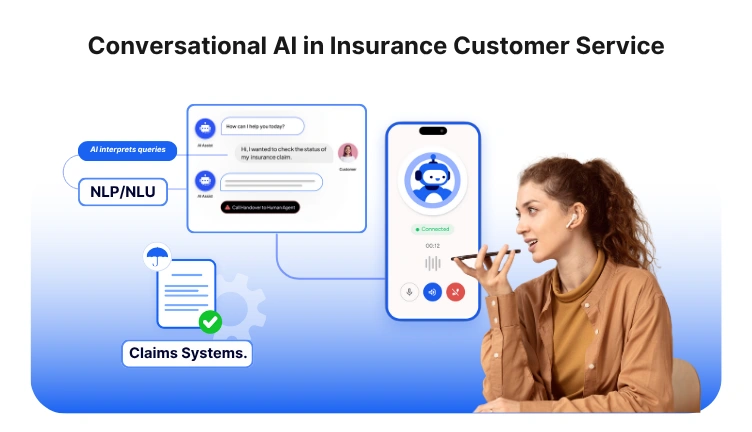
Conversational AI refers to systems (chatbots, AI voice assistants, and virtual assistants) that use natural language understanding (NLU) and natural language processing (NLP) to interact with customers in human-like conversations.
In the insurance industry, this means automated handling of customer inquiries, claims process updates, policy renewals, fraud detection, and more via chat, voice, or both.
Key components:
- NLU & NLP: To understand user intent, even with imperfect input (typos, varied phrasing).
- Machine Learning: To train on past customer data and improve over time (patterns in customer behavior).
- Omni-channel delivery: Across phone calls, voice AI assistants, and chatbots embedded in insurance apps, websites, or messaging platforms.
- Integration with backend systems: Policy databases, claims management systems, CRM tools, and legacy systems to fetch & update information.
Why this matters:
- Insurance customer service often involves manual tasks like answering policy questions, explaining coverage, and tracking claims, which are draining human agents, incurring high operational costs, and are ideal for automation.
- Customers expect self-service and real-time support. If they have to wait hours for a callback or navigate complex IVR menus, satisfaction drops.
- Having a conversational AI platform lets insurance companies scale support, reduce human agent load, and deliver consistent service quality.
Example: Zurich Insurance deployed “Zuri”, an Intelligent Virtual Assistant (IVA), which resolved ~70% of inbound customer queries end-to-end without human intervention, handling tasks like routine claims, modifying policy details, and premium inquiries.
Cut costs and resolve more queries with conversational AI.
Core Use Cases: Where Conversational AI Adds the Most Value in Insurance
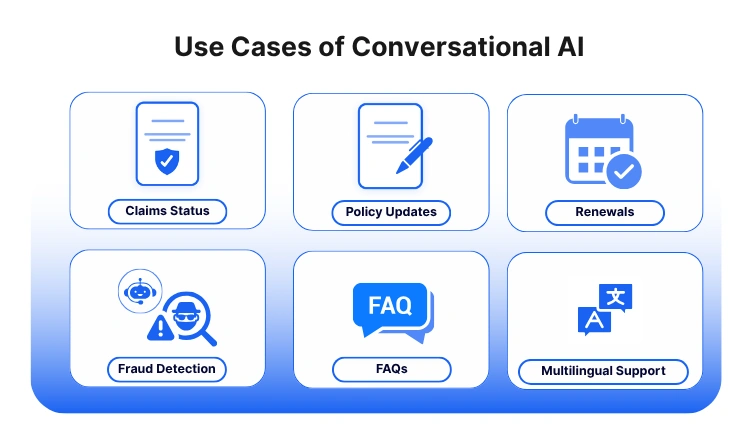
In practice, conversational AI helps with several high-impact insurance customer interactions. Here are the most powerful use cases, with examples and results.
Examples in the field:
- PolyAI offers AI voice assistants for insurance that can be live in about 6 weeks, handling over 50% of customer calls in certain scenarios. It helps manage claims, policy FAQs, payments, etc.
- AXA used a voice assistant during the pandemic to automate recurring interactions (travel insurance, routine calls) and saved roughly 3 minutes per call on average of 15-minute calls; they handled over 100,000 voice bot interactions.
- SecureLi (via Plavno) deployed an AI voice assistant that resolved ~60-63% of incoming calls without forwarding to a human agent. Also, improved first call resolution significantly.
Pinpoint costly use cases and start there for max ROI.
This blog is just the start.
Unlock the power of Convin’s AI with a live demo.

The Business Impact: Metrics that Move the Needle
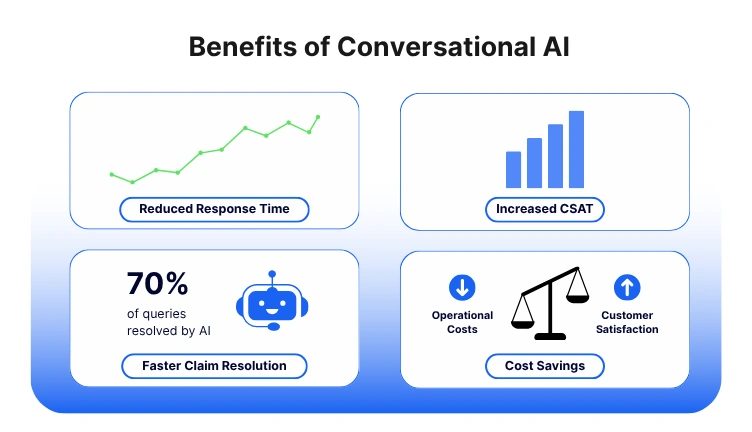
When insurers take conversational AI seriously and implement it well, the operational and strategic benefits are measurable. These are the business outcomes you (and your bosses/C-suite) care about.
Key performance metrics improved by conversational AI:
- Operational efficiency/cost reduction: Automating repetitive and mundane tasks (routine inquiries, repetitive claims steps, premium reminders) means fewer human agent hours, lower overtime, and fewer errors.
- Customer satisfaction & overall customer experience: Reduced wait times, self-service options, empathetic AI voice agents, and 24/7 availability improve CSAT and NPS.
- First call resolution (FCR): AI voice assistants and chatbots that can handle common queries upfront reduce callbacks and transfer rates.
- Claims processing speed/claims cycle time: From FNOL to settlement, many steps can be made transparent and automated.
- Reduced abandonment rates and drop-off in calls/chat: Long IVR menus or slow live agent queues often lead customers to abandon. AI can reduce those by handling simpler queries quickly.
- Revenue & retention: Better engagement, timely premium reminders, proactive outreach, and policy upsell/cross-sell using conversational AI solutions.
Challenges & Best Practices: What to Watch Out For
Before fully committing to conversational AI in insurance, there are risks and pitfalls. Knowing them ahead of time helps ensure better implementation and preserves trust, compliance, and service quality.
Major challenges:
- Accuracy in Natural Language Understanding/NLP limits: Misinterpreting user intent can frustrate customers. AI must handle diverse user queries, slang, and domain-specific terms.
- Integration with legacy and core insurance systems: Conversational AI tools must access policy data, claims systems, payment engines, and fraud detection modules. Poor integrations lead to disconnects or misinformed responses.
- Regulation, security, and privacy concerns: Insurance is heavily regulated. Conversational AI must comply with data protection laws, encryption, consent, and secure authentication.
- Customer behavior and trust: Some customers prefer human agents, especially for complex or emotionally sensitive claims. Voice AI agents must sound human-like but also signal when human escalation is available.
- Maintaining contexts & conversations across channels: When customers move from chatbot to voice or from self-service to a human agent, the conversation context must move with them to avoid repetition.
- Cost of implementation & change management: Training the AI models (machine learning), updating data, hiring or training staff to supervise or maintain the AI, measuring effectiveness, etc.
Best practices to ensure success:
- Start with high-impact, low-complexity use cases (routine tasks, FAQs, policy inquiries) to gain early wins.
- Collect and analyze real customer interactions (voice and chat) to train NLP and machine learning models. Use actual transcripts for scenario coverage.
- Maintain a hybrid model: AI handles routine/repetitive tasks; human agents escalate when necessary.
- Build in continuous improvement loops: monitor error rates and customer satisfaction, and refine conversations and intent profiles.
- Make sure the AI is “human-friendly”: polite, empathetic, able to use human-like language, and able to handle pauses and mistaken inputs gracefully.
- Ensure multilingual capabilities and support for all modes (voice/chat) if your customer base is diverse.
- Measure ROI carefully: cost savings, customer satisfaction, retention, reduction in manual tasks, and operational costs.
Plan for data, supervision, and smooth escalation to succeed.
Why Convin Makes Your Conversational AI Journey Successful
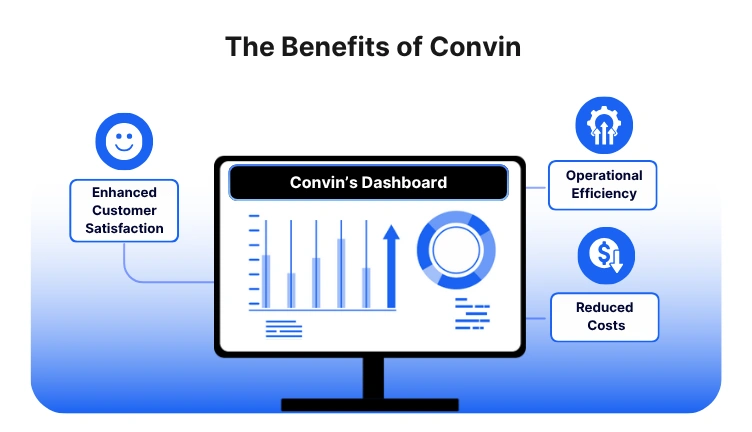
Convin offers AI conversational solutions for insurance companies, enhancing customer engagement, interactions, and experience, making it a standout choice for evaluating platforms or partners.
What Convin offers:
- Full-stack conversational AI platform and tools. We offer chatbot insurance solutions and AI voice assistants that integrate with your existing legacy systems, CRMs, and policy & claims databases, enabling a unified view and action.
- Advanced NLP / natural language understanding (NLU). Our models are trained on real insurance-industry data to correctly classify intents, detect sentiment, deal with ambiguity, and support multiple languages.
- Hybrid model with agent assist and full automation. For more complex claims or risk assessments, Convin ensures human agents can take over smoothly; for routine tasks (premium payment reminders, policy FAQs, and status checks), AI handles them directly.
- Strong compliance, security, and privacy are built in. GDPR, regional regulations, secure authentication, data encryption, and the ability to audit what the AI says.
- Proven case studies & return on investment. We’ve worked with insurance companies, helping reduce costs, improve operational efficiency, and improve overall customer satisfaction.
- Focus on customer satisfaction & experience. Our AI voice assistants emulate human-like interactions, preserving empathy; our chatbots are designed to feel natural and context-aware, not robotic.
How the partnership with Convin works:
- Discovery: Understand your customer service team’s biggest bottlenecks (incoming customer queries, call volumes, claims backlog, etc.).
- Pilot implementation: Choose a use case (e.g., chatbots for claims status, voice assistant for renewals) to prove value.
- Full deployment & integration: With your legacy systems and CRMs.
- Monitoring & iteration: Tracking operational metrics, customer behavior, and feedback; refining models.
Partner with Convin - boost satisfaction and cut costs.
Future Trends: Conversational AI’s Next Frontier in the Insurance Business
If you implement conversational AI now, you’re preparing your insurance business for what’s next. Here are the trends shaping the future, so you can stay ahead of the curve.
- Predictive and proactive conversational AI: AI agents that anticipate customer needs. E.g., notifying customers of premium increases, lapses, upcoming renewals, or new risk exposures before they ask.
- Generative AI and large language models (LLMs): More flexible, context-rich conversations; better summaries of policies/claims; more natural interaction, even for complex insurance jargon.
- Voice-first experiences & multimodal interactions: Voice assistants, including on smart speakers, phone calls, and combining vision, text, and voice.
- Fraud detection & risk assessment powered by AI during customer interactions: Recognizing anomalous patterns in conversational data, flagging suspicious claims early.
- Greater focus on personalization: AI using customer preferences, data, history to tailor not just what is said, but how: tone, channel, suggestions for add-ons, etc.
- Support for more languages & accessibility: Insurance companies serving multicultural populations and global operations will need multilingual AI and accessible interfaces, even for voice in low-bandwidth environments.
Go proactive with voice‑first AI or risk falling behind.
Shaping the Future of Insurance Service
Conversational AI is reshaping insurance customer service. For insurance companies, the promise is clear: reduce operational costs, automate customer service communications that are repetitive or low value, deliver real-time support, and improve overall customer satisfaction.
Meanwhile, customers get faster, more human-like interactions, self-service when they want it, and empathetic handling when they need a human agent.
Conversational AI is now a strategic differentiator if your insurance operations are hindered by high call volumes, repetitive inquiries, or slow claim statuses.
With Convin, you get a partner that understands the insurance industry, builds AI-powered chatbots and voice assistants, integrates with your existing systems, and delivers measurable improvements in customer engagement and customer experience.
Request a personalized demo today and begin transforming your insurance customer service with conversational AI that drives satisfaction, reduces cost, and scales beautifully.
Frequently Asked Questions (FAQs)
- How do insurance companies use conversational AI tools to improve fraud detection?
Conversational AI technology can flag suspicious patterns in customer behavior or claims inputs, prompt additional verification, use voice or chat analytics to detect stress or anomalies, and alert human agents for in-depth risk assessment. This helps reduce fraud in insurance operations.
- Can AI voice assistants handle multilingual customer queries effectively in the insurance sector?
With training on multiple languages and dialects, voice assistants with strong natural language understanding can support multilingual queries, improving customer engagement and satisfaction, especially in diverse markets.
- What role do human insurance agents play when using conversational AI for insurance customer service?
Human agents focus on high-complexity, emotionally sensitive, or risk-laden interactions. AI handles routine tasks, repetitive tasks, premium payment reminders, and first-level claim status checks. Agent-assist features also help human agents respond better based on AI insights.
- How does conversational AI insurance customer service help in risk assessment?
AI can automate the collection of relevant data during claims or policy underwriting, help assess user responses, detect inconsistencies, use machine-learning models to estimate risk scores, and feed data to human underwriters for final decisions.
- What metrics should insurance companies track to measure the success of implementing conversational AI?
Key metrics include percentage of incoming customer queries handled by AI, average handle time, first call resolution (FCR), customer satisfaction (CSAT/NPS), cost per interaction, claims cycle time, abandonment/drop-off rates, and overall operational cost savings.




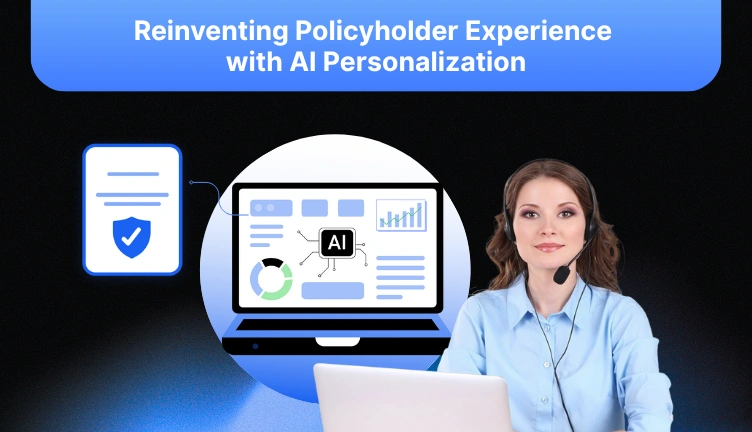



.avif)